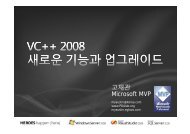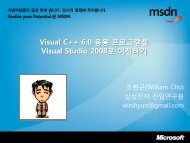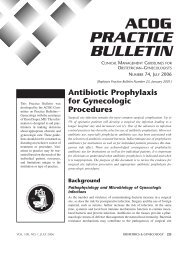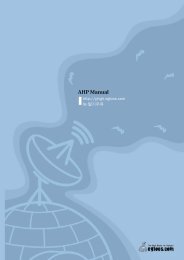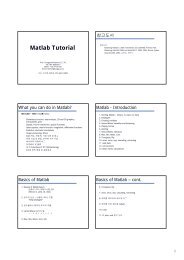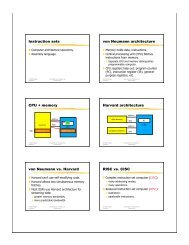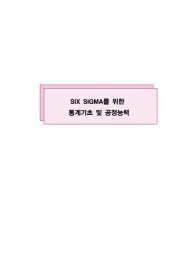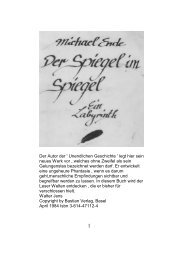Dynamic tire friction models for vehicle traction control - Decision ...
Dynamic tire friction models for vehicle traction control - Decision ...
Dynamic tire friction models for vehicle traction control - Decision ...
You also want an ePaper? Increase the reach of your titles
YUMPU automatically turns print PDFs into web optimized ePapers that Google loves.
Proceedings of tbe 38*Conference on <strong>Decision</strong> & ControlThP07 17:20Phoenix, Arizona USA December 1999<strong>Dynamic</strong> Tire Friction Models <strong>for</strong> Vehicle Traction ControlCARLOS CANUDAS DE WIT^Laboratoire d’Automatique de Grenoble, UMR CNRS 5528ENSIEG-INPG, B.P. 46, 38 40.2 ST. Martin d’lieres, FRANCEPANAGIOTIS TSIOTRAS2School of Aerospace EngineeringGeorgia Institute of Technology, Atlanta, GA 30332-01 50, USAAbstractIn this paper we derive a dynamic <strong>friction</strong> <strong>for</strong>ce model<strong>for</strong> road/<strong>tire</strong> interaction <strong>for</strong> ground <strong>vehicle</strong>s. The modelis based on a similar dynamic <strong>friction</strong> model <strong>for</strong> contactdeveloped previously <strong>for</strong> contact-point <strong>friction</strong> problems,called the LuGre model [4]. We show that thedynamic LuGre <strong>friction</strong> model is able to accurately capturevelocity and roadlsurface dependence of the <strong>tire</strong><strong>friction</strong> <strong>for</strong>ce.1 IntroductionThe problem of <strong>traction</strong> <strong>control</strong> <strong>for</strong> ground <strong>vehicle</strong>s is ofenormous importance to automotive industry. Traction<strong>control</strong> systems reduce or eliminate excessive slippingor sliding during <strong>vehicle</strong> acceleration and thus enhancethe <strong>control</strong>lability and maneuverability of the <strong>vehicle</strong>.Proper <strong>traction</strong> <strong>control</strong> design will have a paramounteffect on safety and handling qualities <strong>for</strong> future passenger<strong>vehicle</strong>s. Traction <strong>control</strong> aims to achieve maximumtorque transfer from the wheel axle to <strong>for</strong>wardacceleration. The <strong>friction</strong> <strong>for</strong>ce in the <strong>tire</strong>lroad interfaceis the main mechanism <strong>for</strong> converting wheel angularacceleration (due to the motor torque) to <strong>for</strong>wardacceleration (longitudinal <strong>for</strong>ce). There<strong>for</strong>e, the studyof <strong>friction</strong> <strong>for</strong>ce characteristics at the roadl<strong>tire</strong> interfacehas received a great deal of attention in the automotiveliterature.A common assumption in most of <strong>tire</strong> <strong>friction</strong> <strong>models</strong>is that the normalized <strong>tire</strong> <strong>friction</strong> pFp=-=F,,Friction <strong>for</strong>ceNormal <strong>for</strong>ceis a nonlinear function of the normalized relative velocitybetween the road and the <strong>tire</strong> (slip coefficient s)with a distinct maximum; see Fig. 1. It is also understoodthat p depends also on the velocity of the <strong>vehicle</strong>and road surface conditions, among other factors (see[3] and [lo]). The curves shown in Fig. 1 illustrate howthese factors influence the shape of p.‘Directeur de Recherche. Corresponding author. Email:canudasQlag.ensieg.inpg.fr‘Associate Professor. Email: p. tsiotrasaae. gatech.edu0-7803-5250-5/99/$10.00 0 1999 IEEE 3746The static model shown in Fig. 1 is derived empiricallybased solely on steady-state experimental data [lo, 11.Under steady-state conditions, experimental data seemto support the <strong>for</strong>ce vs. slip curves of Fig. 1. Nevertheless,the development of <strong>friction</strong> <strong>for</strong>ce at the <strong>tire</strong>lroadinterface is very much a dynamic phenomenon. In otherwords, the <strong>friction</strong> <strong>for</strong>ce does not reach its steady-stateinstantaneously, but rather exhibits significant transientbehavior which may differ significantly from itssteady-state value. Experiments per<strong>for</strong>med in commercial<strong>vehicle</strong>s, have shown that the <strong>tire</strong>lroad <strong>for</strong>ces donot vary along the curves shown Fig. 1, but “jump”from one value to an other when these <strong>for</strong>ces are displayedin the p - s plane [15].In this paper, we develop new, speed-dependent, dynamic<strong>friction</strong> <strong>models</strong> that can be used to describe the<strong>tire</strong>lroad interaction. These <strong>models</strong> have the advantagethat are developed starting from first principlesand are based on simple contact (punctual) dynamic<strong>friction</strong> <strong>models</strong> [4]. Thus, the parameters entering the<strong>models</strong> have a physical significance which allows thedesigner to tune the model parameters based on experimentaldata. The <strong>models</strong> are also speed-dependent,which agrees with experimental observations. A simpleparameter in the model can also be used to capturethe road surface characteristics. Finally, our model isshown to be well-defined everywhere and hence, is appropriate<strong>for</strong> <strong>control</strong> law design.2 Tirelroad <strong>friction</strong> <strong>models</strong>In this study we consider a system of the <strong>for</strong>m:where m is 114 of the <strong>vehicle</strong> mass and J, T are theinertia and radius of the wheel, respectively. v is thelinear velocity, w is the angular velocity, U is the accelerating(or braking) torque, and F is the <strong>tire</strong>lroad<strong>friction</strong> <strong>for</strong>ce. For the sake of simplicity, only longitudinalmotion will be considered. The dynamics of thebraking and driving actuators are also neglected.
Wheel withlumped <strong>friction</strong> PWheel withdistributed <strong>friction</strong> FFigure 2: One-wheel system with: lumped <strong>friction</strong> (left),distributed <strong>friction</strong> (right)particular conditions of constant linear and angular velocity.The Pacejka model has the <strong>for</strong>mF(s) = c1 sin(c2 arctan(c3s - cq(c3s - arctan(ss))>),otui 4Figure 1: Typical variations of the <strong>tire</strong>/road <strong>friction</strong> profiles<strong>for</strong>: different road surface conditions (top),different <strong>vehicle</strong> velocities (bottom). Curves obtainedby Harned in et al [lo].2.1 Slip/Force mapsThe most common <strong>tire</strong> <strong>friction</strong> <strong>models</strong> used in the literatureare those of slip/<strong>for</strong>ce maps. They are definedas oneto-one (memory-less) maps between the <strong>friction</strong>F, and the longitudinal slip rate s, defined as:1 - if v > TW, v # 0 brakings={ (3)1 - & if v < TW,W # 0 drivingThe slip rate results from the reduction of the effectivecircumference of the <strong>tire</strong> (consequence of the treadde<strong>for</strong>mation due to the elasticity of the <strong>tire</strong> rubber),which implies that the ground velocity will not be equalto II = rw. The slip rate is defined in the interval [0,1].When s = 0 there is no sliding (pure rolling), whereass = 1 indicates full sliding.The slip/<strong>for</strong>ce <strong>models</strong> aim at describing the shapesshown in Fig. 1 via static maps F(s) : s c+ F. Theymay also depend on the <strong>vehicle</strong> velocity U, i.e. F(s, U),and vary when the road characteristics change.One of the most well-known <strong>models</strong> of this type is Pacejka'smodel (see, Pacejka and Sharp [13] ), also knownas the "magic <strong>for</strong>mula". This model has been shownto suitably match experimental data, obtained under3747where the 4s are the parameters characterizing thismodel. These parameters can be identified by matchingexperimental data, as shown in Bakker et al. [l].The parameters ci depend on the <strong>tire</strong> characteristics(such as compound, tread type, tread depth, inflationpressure, temperature), on the road conditions (such astype of surface, texture, drainage, capacity, temperature,lubricant, i.e., water or snow), and on the <strong>vehicle</strong>operational conditions (velocity, load); see Pasterkampand Pacejka [12].As an alternative to the static F(s) maps, dynamic<strong>models</strong> based on the dynamic <strong>friction</strong> <strong>models</strong> of Dah1["I1, can be adapted to suitably describe the road-<strong>tire</strong>contact <strong>friction</strong>. <strong>Dynamic</strong> <strong>models</strong> can be <strong>for</strong>mulated asa lumped or distributed <strong>models</strong>, as shown in Fig. 2.This distinction will be discussed next.2.2 Lumped <strong>models</strong>A lumped <strong>friction</strong> model assumes punctual <strong>tire</strong>-road<strong>friction</strong> contact. An example of such a model can bederived from the LuGre model2 (see Canudas et al,[4]), i.e.'Dahl's <strong>models</strong> lead to a <strong>friction</strong> displacement relation thatbears much resemblance with stress-strain relations proposed inclassical solid mechanics.'This model differs from the one in [4] in the way that the func-1tion g(v) is defined. Here we propose to use the term e-Iwp/wa12instead the term e-(u~/u~)2 as in the LuGre model in order tobetter match the pseudo-stationary characteristic of this model(map s ct F(s) ) with the shape of the Pacejka's model, as it willbe shown later.(4)
where 00 is the normalized rubber longitudinal lumpedstiffness, 01 the normalized rubber longitudinal lumpeddamping, 02 the normalized viscous relative damping,pc the normalized Coulomb <strong>friction</strong>, ps the normalizedStatic <strong>friction</strong>,(pc < ps E [0, l]), vs the Stribeckrelative velocity, F, the normal <strong>for</strong>ce, v, = (rw- U) therelative velocity, and a the internal <strong>friction</strong> state.<strong>Dynamic</strong> <strong>friction</strong> <strong>models</strong> specifically <strong>for</strong> <strong>tire</strong>s have beenreported in the work of Clover and Bernard [6], wherethey develop a differential equation <strong>for</strong> the slip coefficient,starting from a simple relationship of the relativereflections of the <strong>tire</strong> elements in the <strong>tire</strong> contactpatch. They still use the semi-empirical static <strong>for</strong>ce/slip<strong>models</strong>, however, to compute the corresponding <strong>friction</strong><strong>for</strong>ce. In that respect, such <strong>models</strong> can be bestdescribed as quasi-dynamic <strong>models</strong>.2.3 Distributed <strong>models</strong>Distributed <strong>models</strong> assume the existence of an area ofcontact (or patch) between the <strong>tire</strong> and the road, asshown in Fig. 2. This patch represents the projectionof the part of the <strong>tire</strong> that is in contact with the road.The contact patch is associated to the frame 0,, withC as the axis coordinate. The patch length is L.Distributed dynamical <strong>models</strong>, have been studied previously,<strong>for</strong> example, in the works of Bliman et al. [2].In these kinds of <strong>models</strong>, the contact patch area is discretizedto a series of elements, and the microscopicde<strong>for</strong>mation effects are studied in detail. In particular,Bliman at al. characterize the elastic and Coulomb<strong>friction</strong> <strong>for</strong>ces at each point of the contact patch, butthen they give the aggregate effect of these distributed<strong>for</strong>ces by integrating over the whole patch area. Theypropose a second order rate-independent model (similarto Dahl’s model), and show that, under constant v andw, there exist a choice of parameters that closely matcha curve similar to the one characterizing the magic <strong>for</strong>mula.Similar results can be obtained by using a model basedin the first-order LuGre <strong>friction</strong> model, i.e.Nevertheless, it is also possible to include different normal<strong>for</strong>ce distribution if necessary, i.e. 6Fn = f(c).Note that Eq. (6) describes a partial differential equation(PDE), i.e.that should be solved in both: time and space.2.4 Relation between distributed model and themagic <strong>for</strong>mulaThe linear motion of the differential bF in the patchframe 0, is C = rw, <strong>for</strong> positive w, and [ = -rw, <strong>for</strong>negative w (the frame origin changes location when thewheel velocity reverses). Hence ( = rlwl. We can thusrewrite (6) in the [ coordinates as:where s = v,./wr = 1 - v/wr. Assuming that U, andw are constant (hence also U,, and s), the above equationdescribes a linear space-invariant system havingthe sign of the relative velocity as its input.The solution of the above equation over the spaceinterval [[(to), [(t~)], or equivalent over [CO,[I], withbz([O) = (0 = 0 isIntroducing this solution together(7), and integrating, we obtainand using (8) we obtain\-,with Eq. (9) in Eq.Finally, we have that F(s), is given aswith g(vr) defined as be<strong>for</strong>e andwhere, dF is the differential <strong>friction</strong> <strong>for</strong>ce, SFn = F,/Lthe differential normal <strong>for</strong>ce, V p = (rw - v) the relativevelocity, and 6z the differential internal <strong>friction</strong> state.This model assumes that:0 the normal <strong>for</strong>ce is uni<strong>for</strong>mly distributed, and0 the contact velocity of each differential state ele-. ment is equal to U,.3748+ F,O~TWSwith 7 = 1 - O1lVrl/g(S) andg(s) = pc + (ps - pc) e-Ipw5/va14<strong>for</strong> some constant w, and s E [0, 11.Uncertainty in the knowledge of the function g(vr), canbe modeled by introducing the parameter 0, as8(vr) = eg(vr) ,where g(v,) is the nominal known function. Computationof the function F(s, e), from Eq. (12) as a function
~ N-1~ N-1Parameter Value Umtsdzi(t) = 6zi. Similarly, we have that0.0018 [s/m]PS 0.9' vs 12.5 [m/s]Table 1: Data used <strong>for</strong> the plot shown in Fig. 3of 8, gives the curves shown in Fig. 3. These curvesmatch reasonably well the experimental data shown inFig. 1-(a), <strong>for</strong> different coefficient of road adhesion usingthe parameters shown in Table 1. Hence, the parameter8, suitably describes the changes in the roadcharacteristics.where each of the can be approximated using <strong>for</strong>warddifferences, as:6zi+1-62;-={ d dzi 7 i=0,1, ... N-24 0 i=N-1Hence, <strong>for</strong> each i-th equation we haveSimilarly,with AF,,i = F, fL, Vi, and A< = LfN, Fcan be approximated as:N -1 N-1F = AFi = (a06zi + ~ 16ii) AFn,iAC+~2vrFni=Oi=Owhich simplifies to:Introducing Z, as the mean value of all the 6zi, i.e.z=- - 6ZiNi=Owe have, from Eq. (14), thatFigure 3: Static view of the distributed LuGre model, un- . 1 N-l Iv Ider different values <strong>for</strong> l/O. Braking case, withv = 20m/s = 72Km/h. These curves show thenormalized <strong>friction</strong> p = F(s) fFn, as a functionof the slip rate s.P = -- (6~i+l - 6zi) TW + U, - ~o;-dZ (15)L i=OdVP)Noticing that E&' (Szi+l - dzi) = 6x0, and taking620 = 0, we have thatNote that the steady-state representation of Eq. (12)can be used to identify the model parameters by feedingthis model to experimental data. These parameters canalso be used in the simpler lumped model, which can beshown to suitably approximate the solution of the PDEdescribed by Eqs. (6) and (7). This approximation isdiscussed next.2.5 From distributed to lumped <strong>models</strong>Under the assumptions given in subsection 2.3 we canapproximate the PDE in Eqs. (6)-(7) by a set of nordinary differential equations via a spatial discretization.To this end, let's divide the contact patch intoN equally spaced discrete points, to each we associatethe "discrete" average displacement 6zi, i.e. dzi =6z(iL/N, t), Vi = 0,1,. ,. N - 1. The space/time scalardz(C, t) is thus approximated by the N-dimensionaltime vector, 6z = [dzo, 6z1,. .., 6zN-I]T where, <strong>for</strong> thesake of simplicity of the notation, we have written3749F = (002 + O I + ~ CzV,) Fn (17)These equations describe the approximate behaviour ofthe PDE, in terms of the mean variable P. When comparedto Eqs. (4)-(5), they indicate that the lumpedmodel can be used as a suitable approximation of thedistributed one. There<strong>for</strong>e, parameters identified fromthe stationary behaviour shown in Fig. 3, can be usedin the lumped model (4)-(5).3 Traction ControlWe consider the one-wheel model with the <strong>tire</strong>lroad<strong>friction</strong> described in Eqs. (1)-(2). Using the pseudcstatic(or steady-state) <strong>for</strong>ce <strong>friction</strong> point of view, the<strong>friction</strong> <strong>for</strong>ce is given as an algebraic (static) function of
the slip coefficient. Typical <strong>friction</strong> <strong>for</strong>ce vs. slip coefficientcurves are shown in Fig. 1. This figure suggests asimple way to achieve maximum <strong>traction</strong> between theroad and the wheel <strong>tire</strong>. Namely, to operate at the maximumpoint of the <strong>friction</strong>/slip curve. This “extremumseeking” <strong>control</strong> strategy requires the a priori knowledgeof the optimal target slip. With the exceptionof [8], where the authors present a <strong>control</strong> algorithmwhich does not require the a priori knowledge of theoptimal slip, current literature does not seem to haveadequately dealt with this problem. Nonetheless, slipand <strong>friction</strong> estimation algorithms have been proposedand verified experimentally in [12].A simple <strong>traction</strong> <strong>control</strong> law using this idea, and basedon sliding mode techniques, is given in [9]. For thesimplified one-wheel <strong>friction</strong> model of Eqs. (1)-(2) this<strong>control</strong> law is given byr T 1+T F-ksgn(S) (18)U= [m(l-sd) Iwhere Sd is the desired slip coefficient, S is given bys = (9 - Sd) TW andIndeed, simple calculation shows thats = (1 - Sd) TdJ - v (20)Substituting Eq. (18) into Eq. (20) and using Eqs. (1)-(2), one obtainsS = -qsgn(S) (21)This implies that S + 0 after S(O)/q seconds. Themajor drawback of the <strong>control</strong> law in Eq. (18) is thatis highly oscillatory due to the zero order sliding modeS = 0. One can reduce the chattering by smoothingthe discontinuity of sgn(.) via low-pass filtering. In thesmoothed implementation of the previous ccntrol law,the term ksgn(S) is replaced by the term ksat(S/@),where = XQ, and where sat(.) is the saturation function.For more details on the previous <strong>control</strong> law, theinterested reader is referred to [9].4 Numerical exampleIn this section we use the <strong>traction</strong> <strong>control</strong> law of the previoussection on two different <strong>friction</strong> <strong>models</strong>. In particular,we are interested in differences between staticand dynamic <strong>friction</strong> <strong>models</strong>. We consider the onewheelmodel with the values shown in Table 1, and:m = 500 Kg, J = 0.2344 Kgm2, T = 0.25m, F,, = mg.The first simulation was per<strong>for</strong>med using the steadystateLuGre model from Eq. (12). The relevant parametersof the LuGre <strong>friction</strong> model are shown in Table 1.The maximum <strong>traction</strong> is achieved <strong>for</strong> sd = 0.15. Theresults of the simulations, using the smoothed versionof the <strong>traction</strong> <strong>control</strong> law presented in the previoussection, are shown in Fig. 4. The second simulation3750x 10‘II5-:-:;yi-2 ‘I0 05 01 0 15 02 0 25 03Time8 3000l?2 100000.05 0.1 0.15 0.2 025 0.3TimO11 , , I0‘ I0 01 01 0 15 02 0 25 03TWFigure 4: Static <strong>friction</strong> model,was per<strong>for</strong>med using the dynamic <strong>friction</strong> model givenin Eqs. (4)-(5) with the values shown in Table 1. Theresults of the simulation are shown in Fig. 5. In bothcases, the initial applied torque <strong>for</strong> both static and dynamiccases was U = 10000Nm. The history profiles ofx lo‘II4’I0.05 0.1 0.15 0.2 025 0.3Tim150001 II0.05 0.1 0.15 0.2 025 0.3Tim0 0 05 01 0 15 02 025 03TIMFigure 5: <strong>Dynamic</strong> <strong>friction</strong> model.the applied torque and the slip coefficient are very similar.The most serious discrepancy between Figs. 4 and5 is the actual <strong>friction</strong> <strong>for</strong>ce developed between the <strong>tire</strong>and the ground <strong>for</strong> the two cases. These figures showclearly that the maximum <strong>friction</strong> <strong>for</strong>ce predicted usingthe dynamic <strong>friction</strong> model is more than three timesthe maximum of the <strong>friction</strong> <strong>for</strong>ce predicted using thestatic <strong>friction</strong> model during the initial transient. Thesteady-state value of the <strong>friction</strong> <strong>for</strong>ce <strong>for</strong> both cases isalmost the same. Since the main mechanism <strong>for</strong> transferringthe axle torque to <strong>for</strong>ward movement is <strong>friction</strong><strong>for</strong>ce, these results suggest that new <strong>traction</strong> <strong>control</strong>algorithms using dynamic <strong>friction</strong> <strong>models</strong> may have anII
advantage over traditional <strong>control</strong> laws based on trackingthe optimal slip coefficient. Finally, Fig. 6 showsthe distances traveled by the wheel <strong>for</strong> each case, alongwith the path of a point at the circumference of thewheel. A complete circle indicates complete slipping(the wheel spins without moving <strong>for</strong>ward) whereas acycloid indicates that the relative velocity of the contactpoint is zero. Because of the higher <strong>friction</strong> <strong>for</strong>cedeveloped in the dynamic <strong>friction</strong> model, the wheel hastraveled a longer distance than <strong>for</strong> the static <strong>friction</strong>case.AcknowledgementsThe LuGre version of the dynamic <strong>friction</strong> model was developedduring the visit of the first author at the Schoolof Aerospace Engineering at the Georgia Institute of Technologyduring December 1998, as part of the CNRS/NSFcollaboration project (NSF award no. INT-9726621/INT-9996096). The first author would like to thank M. Sorineand P.A. Bliman <strong>for</strong> interesting discussions on distributed<strong>friction</strong> <strong>models</strong>.(a) Wheel trajectory with static <strong>friction</strong> model.46 44 6 2 0 02 04 06 08 1 12 14(b) Wheel trajectory with dynamic <strong>friction</strong>model.Figure 6: Comparison of wheel trajectories using staticand dynamic <strong>tire</strong> <strong>friction</strong> <strong>models</strong> (note differentstopping points).5 ConclusionIn this paper, we have derived a new dynamic, speedandsurface-dependent <strong>tire</strong> <strong>friction</strong> model <strong>for</strong> use in <strong>vehicle</strong><strong>traction</strong> <strong>control</strong> design. This model captures veryaccurately most of the main characteristics that havebeen discovered via experimental data. It was alsoshown that distributed <strong>models</strong> can collapse to a lumpedmodel, which is rich enough to capture the main dynamiccharacteristics. Since the main mechanism <strong>for</strong>transferring the axle torque to <strong>for</strong>ward movement is<strong>friction</strong> <strong>for</strong>ce, these results suggest that new <strong>traction</strong><strong>control</strong> algorithms using dynamic <strong>friction</strong> <strong>models</strong> mayhave an advantage over traditional <strong>control</strong> laws basedon simple, static <strong>friction</strong> <strong>models</strong>. Although <strong>for</strong> the sakeof brevity the discussion has been restricted to <strong>traction</strong><strong>control</strong>, the results of the paper have an immediate applicationto the design of ABS systems.3751References[l] Bakker, E., L. Nyborg, and H. Pacejka, “Tyre Modelling<strong>for</strong> Use in Vehicle <strong>Dynamic</strong> Studies,” Society of AutomotiveEngineers Paper # 870421, 1987.[2] Bliman, P.A., T. Bonald, and M. Sorine, “HysteresisOperators and Tire Friction Models: Application to <strong>vehicle</strong>dynamic Simulator,” Prof. of ICIAM. 95, Hamburg, Germany,3-7 July, 1995.[3] Burckhardt, M., Fahnuerktechnik: Radschlupfregelsysteme.Vogel-Verlag, Germany, 1993.[4] Canudas de Wit, C., H. Olson, K. J. Astrom, andP. Lischinsky, “A New Model <strong>for</strong> Control of Systems withFriction,” IEEE TAG, Vol. 40, No. 3, pp. 419-425, 1995.[5] Canudas de Wit, C., R. Horowitz, R. and P. Tsiotras,“Model-Based Observers <strong>for</strong> Tire/Road Contact FrictionPrediction,” In New Directions in Nonlinear ObserverDesign, Nijmeijer, H. and T.1 Fossen (Eds), Springer Verlag,Lectures Notes in Control and In<strong>for</strong>mation Science,May 1999.[6] Clover, C. L. and J. E. Bernard, “Longitudinal Tire<strong>Dynamic</strong>s,” Vehicle System <strong>Dynamic</strong>s, Vol. 29, pp. 231-259,1998.[7] Dahl, P. R., “Solid Friction Damping of MechanicalVibrations,” AIAA Journal, Vol. 14, No. 12, pp. 1675-1682,1976.[8] Drakunov, S., U. Ozgiiner, P. Dix, and B. Ashrafi,“ABS Control Using Optimum Search via Sliding Modes,”IEEE Pansactions on Control Systems Technology, Vol. 3,NO. 1, pp. 79-85, 1995.(91 Fan, Z., Y. Koren, and D. Wehe, A Simple TractionControl <strong>for</strong> Tracked Vehicles. In Proceedings of the AmericanControl Conference, pp. 1176-1177, Seatlle, WA, 1995.[lo] Harned, J., L. Johnston, and G. Scharpf, Measurementof Tire Brake Force Characteristics as Related toWheel Slip (Antilock) Control System Design. SAE Zhnsactions,Vol. 78 (Paper # 690214), pp. 909-925. 1969.Ill] Liu, Y. and J. Sun, “Target Slip Tracking Using Gain-Scheduling <strong>for</strong> Antilock Braking Systems,” In The AmericanControl Conference, pp. 1178-82, Seattle, WA, 1995.[12] Pasterkamp, W. R. and H. B. Pacejka, “The Tire asa Sensor to Estimate Friction,” Vehicle Systems <strong>Dynamic</strong>s,Vol. 29, pp. 409-422, 1997.[13] Pacejka, H. B. and R. S. Sharp, “Shear Force Developmentsby Psneumatic <strong>tire</strong>s in Steady-State Conditions: AReview of Modeling Aspects,” Vehicle Systems <strong>Dynamic</strong>s,Vol. 20, pp. 121-176, 1991.[14] Wong J. Y., Theory of Ground Vehicles. John Wiley& Sons, Inc., New York, 1993.[15] van Zanten, A., W. D. Ruf, and A. Lutz, “Measurementand Simulation of Transient Tire Forces,” in InternationalCongress and Ezposition, (Detroit, MI). SAE TechnicalPaper # 890640, 1989.



